Milwaukee 5387-22 Handleiding
Milwaukee
Boormachine
5387-22
Bekijk gratis de handleiding van Milwaukee 5387-22 (13 pagina’s), behorend tot de categorie Boormachine. Deze gids werd als nuttig beoordeeld door 60 mensen en kreeg gemiddeld 4.5 sterren uit 30.5 reviews. Heb je een vraag over Milwaukee 5387-22 of wil je andere gebruikers van dit product iets vragen? Stel een vraag
Pagina 1/13

OPERATOR'S MANUAL
MANUEL de L'UTILISATEUR
MANUAL del OPERADOR
Cat. No.
No de cat.
5381-20
5387-20
1/2" HAMMER-DRILL
PERCEUSES À PERCUSSION 13 mm (1/2")
13 mm (1/2") TALADRO-MARTILLO
TO REDUCE THE RISK OF INJURY, USER MUST READ AND UNDERSTAND OPERATOR'S
MANUAL.
AFIN DE RÉDUIRE LE RISQUE DE BLESSURES, L'UTILISATEUR DOIT LIRE ET BIEN
COMPRENDRE LE MANUEL DE L'UTILISATEUR.
PARA REDUCIR EL RIESGO DE LESIONES, EL USUARIO DEBE LEER Y ENTENDER EL
MANUAL DEL OPERADOR.

23
SPECIFICATIONS
Capacities
Tool Drill Only
(steel/wood)
Rotary Hammer
(concrete)
Cat. No. Volts
AC Amps No Load
RPM
No Load Blows
per Minute Twist Drill Bit Carbide Tipped
Percussion Bit
5387-20
5381-20
120
120
8.5
8.5
Low 0 - 1000
High 0 - 2500
0 - 1800
16,000
40,000
28,000
1/2" / 1"
3/8" / 3/4"
3/4"
5/8"
SYMBOLOGY
Double Insulated
Amperes
Volts
Alternating Current
No Load Revolutions
per Minute (RPM)
BPM Blows per Minute (BPM)
C US Underwriters Laboratories, Inc.
United States and Canada
Mexican Approvals Marking
FUNCTIONAL DESCRIPTION
1. Side handle
2. Clamping lever
3. Depth guage
4. Hammer/Drill lever
5. Variable speed trigger
6. Forward/Reverse lever
7. Speed/Torque selector(Cat. No. 5387-20 only)
8. Chuck
9. Quik-Lok® cord (Cat. No. 5387-20 only)
Cat. No. 5387-20
9
7 6 5
8
3
4
1
2
PERSONAL SAFETY
GENERAL POWER TOOL SAFETY WARNINGS
WORK AREA SAFETY
ELECTRICAL SAFETY
• Keep work area clean and well lit. Cluttered or
dark areas invite accidents.
• Do not operate power tools in explosive atmos-
pheres, such as in the presence of fl ammable
liquids, gases or dust. Power tools create sparks
which may ignite the dust or fumes.
• Keep children and bystanders away while
operating a power tool. Distractions can cause
you to lose control.
• Power tool plugs must match the outlet. Never
modify the plug in any way. Do not use any
adapter plugs with earthed (grounded) power
tools. Unmodifi ed plugs and matching outlets will
reduce risk of electric shock.
• Avoid body contact with earthed or grounded
surfaces such as pipes, radiators, ranges and
refrigerators. There is an increased risk of electric
shock if your body is earthed or grounded.
• Do not expose power tools to rain or wet condi-
tions. Water entering a power tool will increase
the risk of electric shock.
• Do not abuse the cord. Never use the cord for
carrying, pulling or unplugging the power tool.
Keep cord away from heat, oil, sharp edges
or moving parts. Damaged or entangled cords
increase the risk of electric shock.
• When operating a power tool outdoors, use an
extension cord suitable for outdoor use. Use
of a cord suitable for outdoor use reduces the risk
of electric shock.
• If operating a power tool in a damp location is
unavoidable, use a ground fault circuit inter-
rupter (GFCI) protected supply. Use of an GFCI
reduces the risk of electric shock.
• Do not overreach. Keep proper footing and
balance at all times. This enables better control
of the power tool in unexpected situations.
• Dress properly. Do not wear loose clothing or
jewellery. Keep your hair, clothing and gloves
away from moving parts. Loose clothes, jewel-
lery or long hair can be caught in moving parts.
• If devices are provided for the connection of
dust extraction and collection facilities, ensure
these are connected and properly used. Use of
dust collection can reduce dust-related hazards.
• Do not force the power tool. Use the correct
power tool for your application. The correct
WARNING READ ALL SAFETY WARNINGS AND ALL INSTRUCTIONS. Failure
to follow the warnings and instructions may result in electric shock, fi re and/or serious
injury. Save all warnings and instructions for future reference. The term "power
tool" in the warnings refers to your mains-operated (corded) power tool or battery-operated
(cordless) power tool.
POWER TOOL USE AND CARE
power tool will do the job better and safer at the
rate for which it was designed.
• Do not use the power tool if the switch does not
turn it on and o. Any power tool that cannot be
controlled with the switch is dangerous and must
be repaired.
• Disconnect the plug from the power source
and/or the battery pack from the power tool
before making any adjustments, changing
accessories, or storing power tools. Such pre-
ventive safety measures reduce the risk of starting
the power tool accidentally.
• Store idle power tools out of the reach of chil-
dren and do not allow persons unfamiliar with
the power tool or these instructions to operate
the power tool. Power tools are dangerous in the
hands of untrained users.
• Maintain power tools. Check for misalignment
or binding of moving parts, breakage of parts
and any other condition that may affect the
power tool’s operation. If damaged, have the
power tool repaired before use. Many accidents
are caused by poorly maintained power tools.
• Keep cutting tools sharp and clean. Properly
maintained cutting tools with sharp cutting edges
are less likely to bind and are easier to control.
• Use the power tool, accessories and tool bits
etc. in accordance with these instructions, tak-
ing into account the working conditions and
the work to be performed. Use of the power tool
for operations dierent from those intended could
result in a hazardous situation.
• Stay alert, watch what you are doing and use
common sense when operating a power tool.
Do not use a power tool while you are tired or
under the infl uence of drugs, alcohol or medi-
cation. A moment of inattention while operating
power tools may result in serious personal injury.
• Use personal protective equipment. Always
wear eye protection. Protective equipment such
as dust mask, non-skid safety shoes, hard hat, or
hearing protection used for appropriate conditions
will reduce personal injuries.
• Prevent unintentional starting. Ensure the
switch is in the o-position before connecting
to power source and/or battery pack, picking
up or carrying the tool. Carrying power tools with
your fi nger on the switch or energising power tools
that have the switch on invites accidents.
• Remove any adjusting key or wrench before
turning the power tool on. A wrench or a key left
attached to a rotating part of the power tool may
result in personal injury.
SERVICE
• Have your power tool serviced by a qualifi ed
repair person using only identical replacement
parts. This will ensure that the safety of the power
tool is maintained.
SPECIFIC SAFETY RULES
• Hold power tool by insulated gripping surfaces,
when performing an operation where the cutting
accessory may contact hidden wiring or its
own cord. Cutting accessory contacting a “live”
wire may make exposed metal parts of the power
tool “live” and could give the operator an electric
shock.
• Maintain labels and nameplates. These carry
important information. If unreadable or missing,
contact a MILWAUKEE service facility for a free
replacement.
• WARNING Some dust created by power sanding,
sawing, grinding, drilling, and other construction
activities contains chemicals known to cause
cancer, birth defects or other reproductive harm.
Some examples of these chemicals are:
• lead from lead-based paint
• crystalline silica from bricks and cement and
other masonry products, and
• arsenic and chromium from chemically-treated
lumber.
Your risk from these exposures varies, depending
on how often you do this type of work. To reduce
your exposure to these chemicals: work in a well
ventilated area, and work with approved safety
equipment, such as those dust masks that are spe-
cially designed to fi lter out microscopic particles.
• Wear ear protectors when impact drilling.
Exposure to noise can cause hearing loss.
•
Use auxiliary handle(s), if supplied with the
tool. Loss of control can cause personal injury.

45
Grounded Tools: Tools with Three Prong Plugs
Tools marked “Grounding Required” have a three
wire cord and three prong grounding plug. The
plug must be connected to a properly grounded
outlet (See Figure A). If the tool should electrically
malfunction or break down, grounding provides a
low resistance path to carry electricity away from
the user, reducing the risk of electric shock.
The grounding prong in the plug is connected
through the green wire inside the cord to the
grounding system in the tool. The green wire in the
cord must be the only wire connected to the tool's
grounding system and must never be attached to
an electrically “live” terminal.
Your tool must be plugged into
an appropriate outlet, properly
installed and grounded in ac-
cordance with all codes and
ordinances. The plug and outlet
should look like those in Figure A.
Double Insulated Tools:
Tools with Two Prong Plugs
Tools marked “Double Insulated” do not require
grounding. They have a special double insula-
tion system which satisfi es OSHA requirements
and complies with the applicable standards of
Underwriters Laboratories, Inc.,
the Canadian Standard Asso-
ciation and the National Elec-
trical Code. Double Insulated
tools may be used in either of
the 120 volt outlets shown in
Figures B and C.
Fig. A
GROUNDING
WARNING Improperly connecting the
grounding wire can result in the risk of elec-
tric shock. Check with a qualifi ed electrician
if you are in doubt as to whether the outlet is
properly grounded. Do not modify the plug
provided with the tool. Never remove the
grounding prong from the plug. Do not use
the tool if the cord or plug is damaged. If
damaged, have it repaired by a MILWAUKEE
service facility before use. If the plug will not
fi t the outlet, have a proper outlet installed by
a qualifi ed electrician.
Grounded tools require a three wire extension
cord. Double insulated tools can use either a two
or three wire extension cord. As the distance from
the supply outlet increases, you must use a heavier
gauge extension cord. Using extension cords with
inadequately sized wire causes a serious drop in
voltage, resulting in loss of power and possible tool
damage. Refer to the table shown to determine the
required minimum wire size.
The smaller the gauge number of the wire, the
greater the capacity of the cord. For example, a 14
gauge cord can carry a higher current than a 16
gauge cord. When using more than one extension
cord to make up the total length, be sure each cord
contains at least the minimum wire size required.
If you are using one extension cord for more than
one tool, add the nameplate amperes and use the
sum to determine the required minimum wire size.
Guidelines for Using Extension Cords
• If you are using an extension cord outdoors, be sure
it is marked with the suffi x “W-A” (“W” in Canada)
to indicate that it is acceptable for outdoor use.
• Be sure your extension cord is properly wired
and in good electrical condition. Always replace a
damaged extension cord or have it repaired by a
qualifi ed person before using it.
• Protect your extension cords from sharp objects,
excessive heat and damp or wet areas.
READ AND SAVE ALL
INSTRUCTIONS FOR FUTURE USE.
* Based on limiting the line voltage drop to fi ve volts at
150% of the rated amperes.
EXTENSION CORDS
Recommended Minimum Wire Gauge
For Extension Cords*
Extension Cord Length
Nameplate
Amperes 25' 50' 75' 100' 150'
0 - 2.0
2.1 - 3.4
3.5 - 5.0
5.1 - 7.0
7.1 - 12.0
12.1 - 16.0
16.1 - 20.0
18
18
18
18
16
14
12
18
18
18
16
14
12
10
18
18
16
14
12
10
--
18
16
14
12
10
--
--
16
14
12
12
--
--
--
ASSEMBLY
WARNING To reduce the risk of injury,
always unplug tool before attaching or remov-
ing accessories or making adjustments. Use
only specifi cally recommended accessories.
Others may be hazardous.
Removing and Replacing Quik-Lok
® Cords
(Cat. No. 5387-20)
MILWAUKEE's exclusive Quik-Lok
®
Cords provide
instant fi eld replacement or substitution.
Fig. 1
1.To remove the Quik-Lok® Cord, turn the cord nut
1/4 turn to the left and pull it out.
2.To replace the Quik-Lok
® Cord, align the connec
tor keyways and push the connector in as far as it
will go. Turn the cord nut 1/4 turn to the right to lock.
Installing Bits into Keyed Chucks
Be sure that the shank of the bit and the chuck
jaws are clean. Dirt particles may cause the bit
to line up improperly.
Do not use bits larger
than the maximum
recommended ca-
pacity of the drill be-
cause gear damage
or motor overload-
ing may result. For
best performance, be
sure that the bits are
properly sharpened
before use.
1. Unplug the tool.
2. Open the chuck jaws wide enough to insert a bit.
Allow the bit to strike the bottom of the chuck.
Center the bit in the chuck jaws and tighten the
jaws by hand to align the bit.
3. Place the chuck key into each of the three holes
in the chuck, turning it clockwise to tighten the
chuck securely.
NOTE: Never use a wrench or means other than
a chuck key to tighten or loosen the chuck.
4. To remove the bit, insert the chuck key into one of
the holes in the chuck and turn it counterclockwise.
Fig. 2
Loosen
Tighten
Adjusting the Side Handle Position
1. Loosen the side handle by unscrewing the side
handle grip until the side handle rotates freely.
2. Rotate the side handle to the desired position.
3. Tighten the side handle grip securely.
WARNING To prevent personal injury,
always remove the chuck key from the chuck
after each use.
WARNING To reduce the risk of injury,
always use a side handle when using this tool.
Always brace or hold securely.
Fig. 3
Clamping lever
Side handle
grip
2. Slide the depth gauge rod backward or forward
until it is set for the desired depth (Fig. 4).
NOTE: The drilling depth is the distance between
the tip of the bit and the tip of the depth gauge
rod.
3. Release the clamping lever.
Setting the Depth Gauge
1. Press in the clamping lever (Fig. 3).
Chuck Removal
This tool is equipped with a threaded spindle to
hold the chuck. Before removing the chuck, unplug
the tool and open the chuck jaws. A left-handed
thread screw is located inside the chuck to pre-
vent the chuck from loosening when the tool is
operated in reverse direction. Remove the screw
by turning it clockwise. To remove the chuck, hold
the tool so that only the side of the chuck rests
fi rmly and squarely on a solid workbench. Insert
the chuck key or
a chuck remover
bar in one of the
keyholes. Turn
the chuck so the
key is at about a
30° angle to the
bench top and
strike the key
sharply with a
hammer so the
chuck turns in
a counterclock-
wise direction
(lo o k ing from
the front of the
tool). This should
loosen the chuck
from the spindle
which has a right hand thread making it easy to
remove the chuck by hand.
NOTE: When replacing the chuck, always replace
the left hand thread screw in the chuck.
Fig. 4
Drilling Depth
WARNING To reduce the risk of injury,
always wear eye protection.
Fig. 5
Fig. B Fig. C
Product specificaties
| Merk: | Milwaukee |
| Categorie: | Boormachine |
| Model: | 5387-22 |
Heb je hulp nodig?
Als je hulp nodig hebt met Milwaukee 5387-22 stel dan hieronder een vraag en andere gebruikers zullen je antwoorden
Handleiding Boormachine Milwaukee
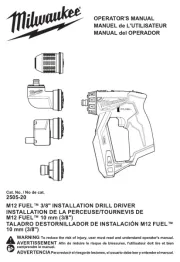
19 Augustus 2025
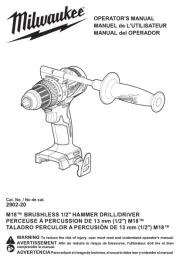
19 Augustus 2025
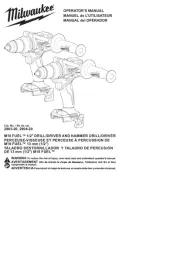
19 Augustus 2025
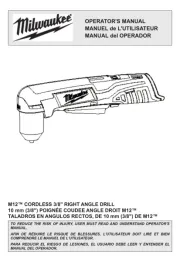
19 Augustus 2025
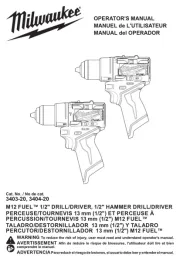
19 Augustus 2025
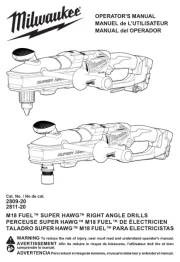
18 Augustus 2025
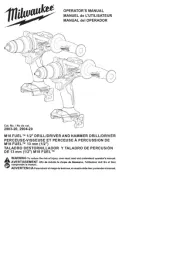
18 Augustus 2025
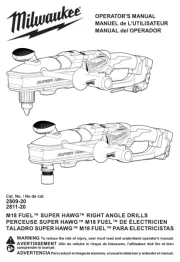
18 Augustus 2025
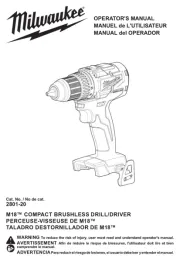
18 Augustus 2025
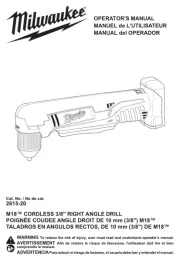
18 Augustus 2025
Handleiding Boormachine
- Skil
- Fein
- Topcraft
- Defort
- Yato
- Festool
- Carat
- Workzone
- Robust
- Cotech
- Kress
- Varo
- Rupes
- Powerfix
- Brandson
Nieuwste handleidingen voor Boormachine
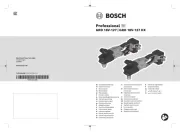
16 September 2025
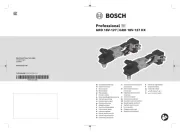
16 September 2025
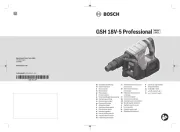
15 September 2025
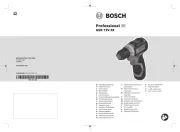
15 September 2025
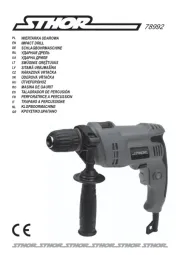
13 September 2025
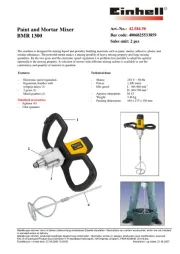
13 September 2025
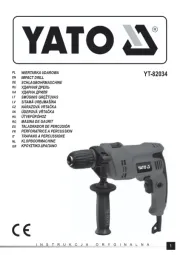
12 September 2025
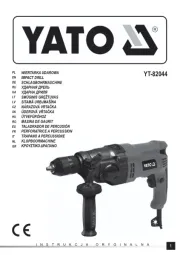
12 September 2025
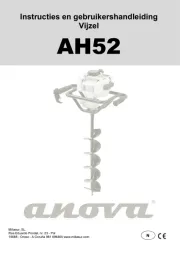
9 September 2025
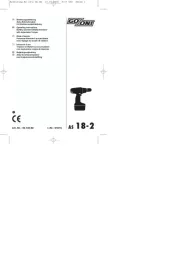
8 September 2025